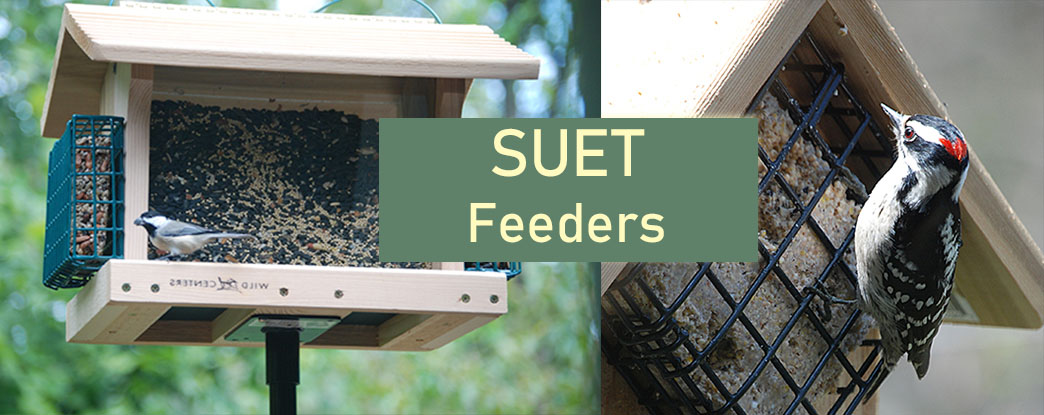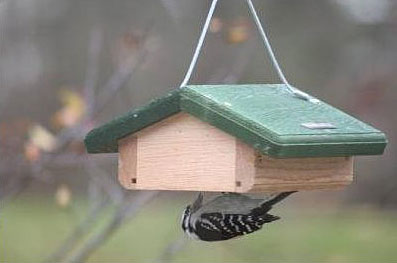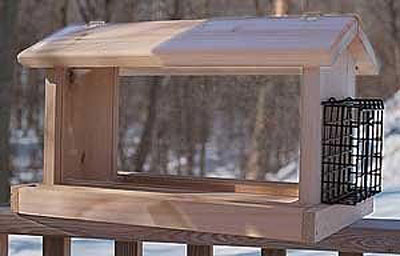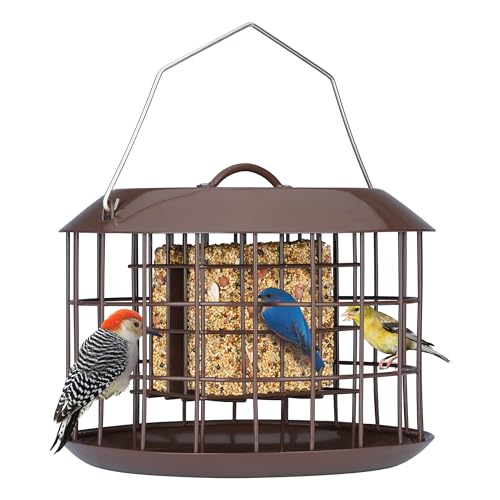
Suet feeders are bird favorites. Depending on the species, suet feeders can attract several bird species – from woodpeckers, chickadees, nuthatches, and jays to creepers, wrens, bluebirds, and mockingbirds.
Some homemade suets can be spread on a tree trunk or limb, so no feeder is required. However, if you do decide to offer your backyard birds some durable to hold on to, these are the best ones on the market!
Birdzilla.com is reader-supported. If you click through the links we provide, we may earn a commission.
On this page
Best Suet Feeders
Our Top Pick: Suet Bird Feeder for Outside [Double Capacity]
This suet feeder is a strong metal structure with a roof and two feeding cages. To help weatherproof it, this feeder also has a plastic coating. It comes with a good rope to hang it from a pole or branch and is very easy to install.
Each feeding cage is easy to open and close and is just the right size for the average suet cake.
Although this feeder was designed for holding two suet cakes at a time, it can also be used for seed cakes, mealworm cakes, and even orange slices.
Related: What do woodpeckers eat?
Its warm brown color is a good fit for every backyard, and the feeding cages provide good perches for chickadees, titmice, woodpeckers, and other birds that like suet.
While mealworm and suet cakes work best during the winter months, in spring and summer, we can also experiment with nesting materials. See which birds arrive to take grass, small twigs, and other bits of vegetation!
Birds Choice – Taupe Base with Brown Roof
This hanging feeder has a unique design that is ideal for woodpeckers. Although small woodpeckers like the Downy and Hairy can visit and feed, it’s also suitable for Red-bellied Woodpeckers and even the big Pileated Woodpecker.
The simple yet effective design of this foot-high feeder includes an elongated cedar block with a small rectangular top. There is a space behind tough wire mesh that holds suet or a seed cake, and the feeder is hung with a vinyl-coated steel cable.
Wide mesh makes it easy for smaller and larger woodpeckers to hold on, and can be used by other bird species as well.
Although squirrels will try to get at this feeder, it can be hung far enough to keep them from leaping to it.
winemana Outdoor Suet Bird Feeder
This suet feeder has a basic but effective design that should work well for chickadees, small woodpeckers, and other species that like to feed on suet. It can also be used for a seed cake, and, in the spring and summer, can be filled with orange slices for orioles.
Made of stainless steel, this feeder also has a rust-proof coating to help protect it from the elements.
The metal roof is basic, but shelters the suet or seed cake from sun, rain, and snow. It can also be easily removed to fill the feeder.
Since it only holds one suet or seed cake, you might need to clean and fill the feeder more often but it will work fine to feed the birds.
Cleaning this feeder is also simple. All you need to do is rinse the empty feeder and/or soak it in warm water. It will work best by hanging it from a pole for easy viewing.
Kingsyard Squirrel Proof Suet Feeder
This metal feeder is designed to provide woodpeckers and other small birds with suet and seed cake. It has a rounded or cylindrical shape with a flat metal top, shallow metal bottom, and an exterior metal cage.
This metal cage has 1.32 by 1.75 inch openings meant to keep squirrels away from the suet or seedcakes in the middle of the feeder. Those types of bird food are placed in a pair of smaller metal cages accessible by removing the top of the feeder.
It is a bit more than 9 inches tall and more than 9 inches wide, and also comes with a cable to hang it from a branch or a pole. Keeping the suet or seedcakes in the middle of the feeder doesn’t just keep them out of reach of squirrels. It also helps to protect them from sun and rain.
The bottom of the feeder works to collect fallen seeds and other bits of food.
Kingsyard Double Suet Bird Feeder with Weatherproof Roof
The Kingsyard Double Suet Feeder is a standard, effective, and durable feeder perfect for small woodpeckers and other species. Entirely made of metal, it is 8 inches tall by 6 and a half and five inches wide, and has a cute little red roof.
The feeder has a powder-coated finish to keep it from rusting, and has a metal cage structure meant to hold two different suet cakes. Although it can also hold seed cakes, this feeder doesn’t have a tray to catch any falling seeds.
On this feeder, metal perches on each side also make it possible for two birds to feed at the same time. The removable roof makes it simple to fill and clean this suet feeder, and it can be easily hung from a pole.
This is a great little suet feeder that works well on its own as well as in conjunction with seed and mealworm feeders.
What you should know
Feeding suet is one of the least expensive and most effective choices for feeding birds. Suet cakes are clean and easy to store and easy to use. Suet cakes do not create problems with seed hulls or germinating seeds under feeders.

This suet feeder is designed to force the bird to feed upside down, a snap for chickadees and nuthatches but an effective approach to elimination of House Sparrows and starlings.

This hopper feeder has wire cages for suet located on either end of the feeder.
See more bird feeder types:
- Dome feeders – Dome feeders are useful for protecting birdseed from larger birds and weather. They are typically used by smaller birds, who can cling to the sides of the feeder.
- Hopper feeders – Hopper feeders are useful for holding larger quantities of bird seeds, and they can be used by a variety of bird species, including jays, cardinals, and grosbeaks.
- Peanut feeders – Peanut feeders are useful for holding peanuts and other nut-based bird food, and they are typically used by birds such as woodpeckers, jays, and nuthatches.
- Platform feeders – Platform feeders are useful for holding a variety of bird food. They are typically used by ground-feeding birds, such as sparrows and doves, as well as larger birds, such as jays and cardinals.
- Tube feeders – Tube feeders are useful for holding small seeds, such as nyjer, and are typically used by finches and other small birds that can cling to the sides of the feeder.
- Window-mounted feeders – Window-mounted feeders are useful for people who have limited space in their yards.
- Bird feeders with a camera – Bird feeders with cameras are relatively new in the birdwatching scene, but these feeders allow you to easily identify all the different birds that visit your feeder.


![Suet Bird Feeder for Outside [Double Capacity] Suet Wild Bird Feeder with Hanging Metal Roof, Suet Feeders for Outside, for Use with Suet Cakes, Seed Cakes, Mealworm Cakes](https://m.media-amazon.com/images/I/518Ssi2jQnL.jpg)



